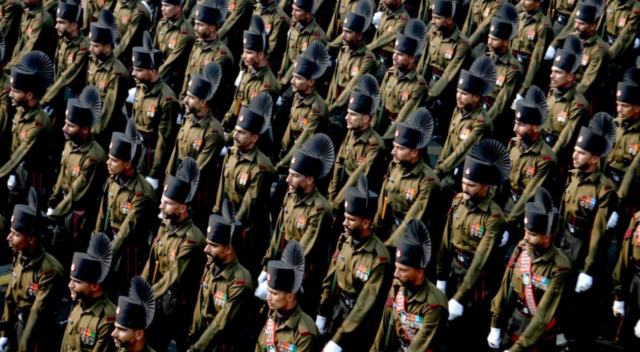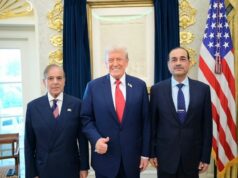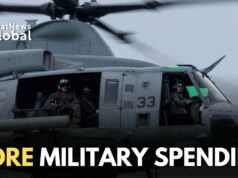NEW DELHI: The second stage of reforms in India’s higher defence management is likely to get off the ground over the next two to three months with the military leadership in the process of finalising the contours of at least two joint theatre commands to be formed this year, all indications suggest.
The Chiefs of Staff Committee (CoSC) under the chairmanship of Chief of Defence Staff Gen Bipin Rawat is likely to discuss two studies authored by the vice chiefs of the Indian Navy and the Indian Air Force for creation of the Maritime Theatre Command and an Integrated National Air Defence Command over the next few days.
From all indications available in the public domain, the Maritime Theatre Command (MTC), to be headed by a three-star (Vice Admiral) level naval officer will include the existing Eastern and Western Naval Commands, a scaled-down Andaman and Nicobar Command, the Southern Air Command and two brigades of the Army, capable of carrying out amphibious operations, besides two squadrons of the air force’s maritime strike aircraft.
To be most likely headquartered in Karwar in Karnataka, which has one of the biggest naval bases in the country, the Maritime Theatre Command will have a vast area of responsibility stretching from the western Indian Ocean to the western Pacific (in keeping with India’s definition of the Indo-Pacific region). The Andaman Nicobar Command, India’s first tri-services command, in its 20th year currently, is likely to revert to being Fortress Andaman and Nicobar or FORTAN to be headed by a Lt General or equivalent officer in the other two services by turn. The head of FORTAN will report to the Flag Officer Commanding-in-Chief (FOC-in-C), Eastern Naval Command, according to the recommendation of the study on Maritime Theatre Command. While the Air Force element in the Maritime Theatre Command will be provided by the assets of the Southern Air Command based in Trivandrum, two squadrons of the IAF, comprising its maritime strike aircraft Jaguars and Su-30s, based in Jamnagar and Thanjavur respectively, will also form part of the Maritime Theatre Command.
The Trivandrum-based 91 Brigade and the Port Blair-based 108 Mountain Brigade will provide the Army element in the MTC. Both these brigades have been working in tandem with the Indian Navy for years and are well-versed with the requirements of maritime operations, quite distinct from land-based manoeuvres.
While the structure of the MTC looks more or less settled, the details of the National Air Defence Command are yet to be firmed up although the concept is agreed upon that all the air defence assets currently with IAF, Army and Navy are to be brought under a centralised control system. The headquarters of the new air defence command is likely to be located either at Allahabad or at Nagpur, reports say and it is certain to be headed by an Air Force officer of the three star rank.
However, unlike the MTC, the Air Defence Command has some bigger practical difficulties to overcome since the air defence assets, systems and equipment that all the three forces hold currently are diverse and of different vintage. In addition, the personnel of the three services handling air defence are trained differently. Combining all the assets and getting everyone on the same page will be a mammoth and time-consuming job, according to those dealing with the task of integrating the disparate elements.
There are some reports that an announcement of creation of the two theatre commands may come as early as August after the Cabinet Committee on Security (CCS) approves it. The implementation may take some more time though. Once the first two theatre commands are rolled out, the top military leadership is likely to turn their attention to the creation of two or three more theatre commands to be headed by Army officers.
One school of thought is that there should be one theatre each for the western front (against Pakistan) for the entire northern front against China. However, given the twin challenges of a vast frontage of the northern borders and complexities of handling a proxy war waged by Pakistan in Jammu and Kashmir, another view is to have a western theatre command (for Pakistan), Northern Command (to include Jammu and Kashmir, Ladakh and the northern border west of Nepal), and an Eastern Command (starting from east of Nepal and extending to the Myanmar and Bangladesh borders). Discussions for finalisation of these commands are currently on but their approval may come in the third stage, according to all indications available so far.
The theatre commanders will become the operational commanders once the commands are rolled out and will be taking instructions from the Chiefs of Staff Committee (CoSC), headed by the CDS and comprising the three Chiefs of Staff of the respective services. The Chiefs will thus continue to have a say in operational matters through the CoSC. However, they will mainly be responsible to raise, train and sustain the three services. All these steps are likely to get implemented progressively.
What however certain is that the move towards jointness and integration of the three armed forces is an irreversible process since the decision has been approved by the CCS, India’s highest decision-making body on security matters way back in mid-2019. The ball was set rolling on 30 December 2019 with the appointment of Gen. Bipin Rawat as the first Chief of Defence Staff (CDS).
The announcement of creation of India’s first CDS was made by Prime Minister Narendra Modi from the Red Fort during his customary Independence Day Speech on August 15. While making the announcement, the Prime Minister said: “India should not have a fragmented approach. Our entire military power will have to work in unison and move forward. All the three (Services) should move simultaneously at the same pace. There should be good coordination and it should be relevant to the hope and aspirations of our people. It should be in line with the changing war and security environment with the world. After formation of this post (CDS), all the three forces will get effective leadership at the top level.”
As a follow up, four months later, on December24, 2019, the government notified the appointment of the CDS. It also went a step further by creating a Department of Military Affairs (DMA) and made the CDS the Secretary of the Department within the Ministry of Defence. The CDS, now the principal military adviser to the government, is also the Permanent Chairman CoSC. Among many other tasks mandated to him, according to an official press note issued that day, the CDS is to function as the Military Adviser to the Nuclear Command Authority, bring about jointness in operation, logistics, transport, training, support services, communications, repairs and maintenance, etc of the three Services, within three years, ensure optimal utilisation of infrastructure and rationalise it through jointness among the services, and finally bring about reforms in the functioning of three Services aimed at augmenting combat capabilities of the Armed Forces by reducing wasteful expenditure.
The DMA meanwhile, is now manned by a mix of civilian and military officials with a three star Army officer designated as additional secretary (No. 2 to the CDS, who is also Secretary, DMA) and three major general rank officers drawn from each service are also serving as joint secretaries. Two civilian officers are also part of the DMA as joint secretaries. This arrangement is certainly a major departure from the past and is indicative of the change that is currently underway in the MoD.
Difficulties in implementation of major plans notwithstanding, India’s defence reforms are well and truly on.
Nitin A. Gokhale is a media entrepreneur, one of South Asia's leading strategic affairs analyst and author of over a dozen books so far on military history, insurgencies and wars.
Starting his career in journalism in 1983, he has since led teams of journalists across media platforms.
A specialist in conflict coverage, Gokhale has covered the insurgencies in India’s North-East, the 1999 Kargil conflict and Sri Lanka’s Eelam War IV between 2006-2009.
Gokhale now travels across the globe to speak at seminars and conferences, and lecture at India’s premier defence colleges. He has founded three niche portals, Bharatshakti.in, stratnewsglobal.com and Interstellar.news.





